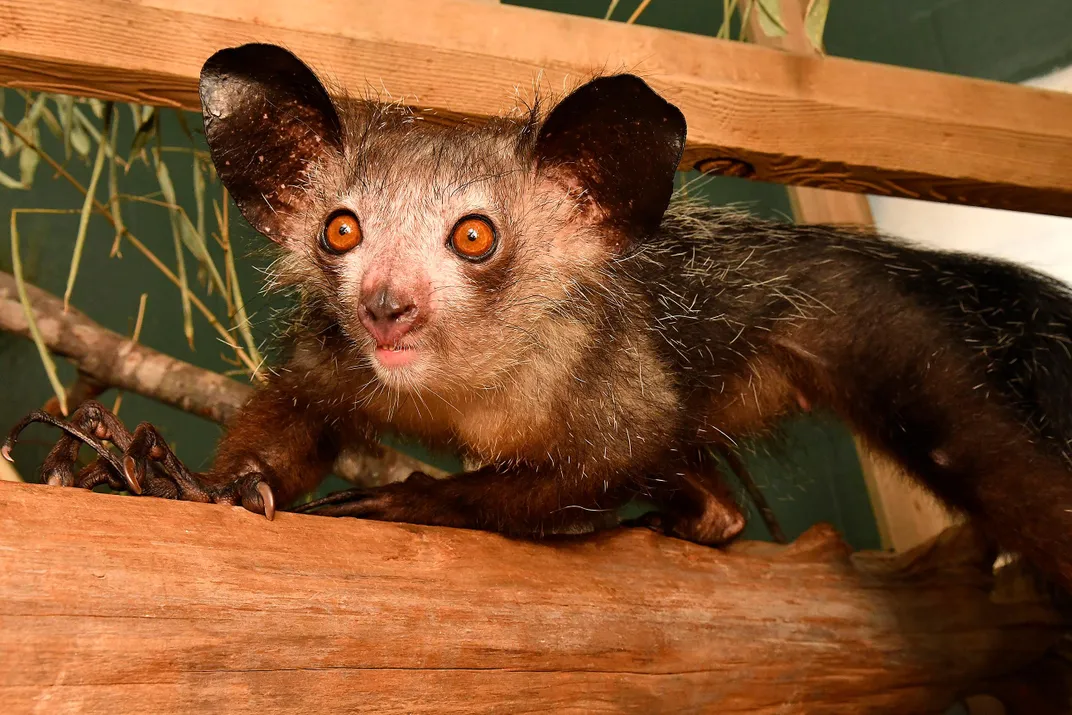Extra Thumb Discovered on Aye-Aye Lemurs, Giving These Primates Six Fingers
Used for gripping limbs, a “pseudo-thumb” makes the hands of these bizarre primates even creepier
/https://tf-cmsv2-smithsonianmag-media.s3.amazonaws.com/filer/5f/e3/5fe31530-e4cf-4680-9d96-f32bdfd65627/214278_web.jpg)
Aye-aye lemurs look a bit like gremlins, with pronounced, clawed middle fingers, and these primates’ hands have been fascinating scientists for years. New research shows that the little lemurs, ugly enough to rouse superstitions in their home range in Madagascar, sport an extra tiny thumb complete with fingerprints, giving these animals six fingers.
“It has the most amazing anatomy of any primate,” says Adam Hartstone-Rose, an associate professor of biological sciences at North Carolina State University and the lead author of a study published today in the American Journal of Physical Anthropology. “There’s nothing else on Earth like an aye-aye.”
Aye-ayes are a little bigger than your average house cat, with massive ears that look like a mix between a bat and a cow. The ears are equipped for echolocation, and aye-ayes are the largest nocturnal primates in the world, Hartstone-Rose says. They have giant incisors that never stop growing and are covered in wiry hair, and they have the largest brains of any living lemur species. Even their babies look like a version of the chupacabra—a blood sucking beast in Latin American folklore.
But despite all the aye-aye’s bizarre features, their hands are perhaps their strangest attribute. The four fingers are primary thumb are long and spindly. “It kind of looks like a cat walking on spiders,” Hartstone-Rose says.

Hartstone-Rose has dissected hundreds of primates, often focusing on forearm anatomy where most of the muscles that control the fingers reside. He studies how primate muscles have adapted for different types of behaviors. He’d long wanted to take a peek at the anatomy of an aye-aye, but even dead ones weren’t easy to get ahold of. “Aye-ayes are super rare animals. There are only about 30 of them in captivity anywhere in the United States,” he says.
Colleagues at Duke University’s Lemur Center finally found Hartstone-Rose an aye-aye to study, which resulted in a flurry of research on the relatively unknown species. Dissection revealed that aye-ayes have an extra thumb, which researchers call a pseudo-thumb. The small structure made of bone and cartilage can move in three different directions, similar to the way human thumbs move.
Katharine Thompson, a PhD candidate in anthropology at Stonybrook University who studies lemurs, says that the animals are very difficult to observe in the wild because of their cryptic nature. “So much of their behavior is best understood through their morphology.”
Hartstone-Rose says pseudo-thumbs are known from a few different animals. All bears used to have these digits, but most living species have lost them as they plodded around on the ground. The giant panda is the only bear that still has a pseudo-thumb, used for gripping the bamboo they feed on. Some rodents also developed pseudo-thumbs for similar reasons, to grasp twigs and grass.
A few species of extinct aquatic reptiles also had pseudo-thumbs to allow them to widen their flippers and improve their swimming efficiency. Some moles also have a pseudo-thumb to allow them to dig better.
But aye-ayes developed this digit for completely different reasons. Hartstone-Rose says that it likely came about because their fingers and actual thumb are so specialized for finding food. Aye-ayes have very peculiar foraging and feeding habits. They tap rotting wood with their fingers and use their massive ears to find hollow spots, indicating the tunnels made by wood-boring bugs.
“They make a mental map with that enormous brain they have,” Hartstone-Rose says. Once they find an intersection of these tunnels, they gnaw into the wood using large incisors. At this point, they use their long, slender middle finger with a large claw.
“They stick this horrible middle finger in the hole to fish out grubs from all different directions,” Hartstone-Rose says, adding that “one of the creepiest things they do is bite a hole into the top of an egg and use that finger to scoop into it and slurp it out.”
But all this feeding specialization means the arboreal aye-ayes would have trouble grasping with their four fingers and regular thumb, which is also long and spindly. The development of the pseudo-thumb adds a great deal of grip, exerting an amount of force equal to half the lemurs’ body weight.
Nancy Stevens, a biomedical sciences professor at Ohio University who was not involved in the recent study, says the research by Hartstone-Rose and colleagues “underscores not only the profound uniqueness of the aye-aye, but also the fact that so much remains to be discovered about primate adaptations to the natural world.”
Stevens, who has studied fossil lemurs from mainland Africa, says that aye-ayes and some of their extinct relatives are so unique that they might have colonized Madagascar independently from other lemurs. “It’s important to emphasize that habitat conservation remains key to expanding knowledge and ensuring the long-term survival of the aye-aye, in addition to scores of other animals, plants and other fascinating aspects of Madagascar’s incredible biodiversity,” she says.
Aye-ayes are listed as endangered by the International Union for Conservation of Nature, mostly due to deforestation and habitat loss, though its creepy looks also make it the target of killings in some parts of Madagascar. Some local beliefs consider the creature taboo, Hartstone-Rose says.
But since aye-ayes are the only living member of their family, he says their extirpation “would be a horrible loss to science.”
/https://tf-cmsv2-smithsonianmag-media.s3.amazonaws.com/accounts/headshot/joshua-learn_copy.jpg)


/https://tf-cmsv2-smithsonianmag-media.s3.amazonaws.com/accounts/headshot/joshua-learn_copy.jpg)